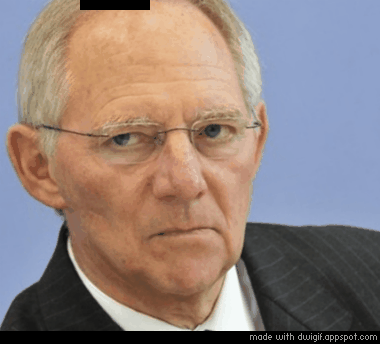Your forexlive.com ENewsletter |  |
- ForexLive North American wrap: payrolls pain
- Next Wk/US: PPI, Trade Balance, Claims, UMich, Tsy Statement
- CAD longs explode in CFTC report
- US DATA: April STRIPS +$1.676b and +$1.886b ex…….
- Primary dealer poll sees 32% chance of QE3
- Charlie Munger: “Civilized people don’t buy gold”
- S&P cuts Spanish regions
- Four reasons for oil’s decline
- Norway dumps Ireland, Portugal bonds on euro crisis concern
- Repeat: US Apr Jobs +115K, Unemp 8.1%, Another Modest Month
- Sarko cuts lead to 4 in Ifop poll
- Greece’s Venizelos: Elections will judge if Greece stays in euro
- Kroll COO:Exploring Idea Of Rating Sovereigns In The Future
- Another sad day for music
- Why Wall Street fears a Socialist French leader
- Super Sunday poses multiple threats to Merkel
- This slip and slide keeps on goin’
- Schaeuble: Germany is ready to deal with Hollande
- More Limbo After April US Jobs: Consolidation or New Trend?
- Fed’s Williams: People ‘are just giving up’ on finding work
| ForexLive North American wrap: payrolls pain Posted: 04 May 2012 01:23 PM PDT
The market didn’t know what to do with the non-farm payrolls report at first but the eventual takeaway was decidedly negative. EUR/USD climbed to 1.3179 but offers at 1.3180 kicked in and beat the euro down to 1.3080. USD/JPY whipsawed ahead of the NFP data, raising the ire of those suspecting the number was leaked moments early. The pair bounced to 80.39 but steadily declined to 79.83 afterwards. Cable was choppy before healing lower as flows in EUR/GBP and stop-hunting sent the pair above 1.62 before a retreat to 1.6142. USD/CAD legged higher on the employment report to 0.9920 and then to 0.9960 after the Ivey PMI and as stock sank. |
| Next Wk/US: PPI, Trade Balance, Claims, UMich, Tsy Statement Posted: 04 May 2012 12:50 PM PDT By Kasra Kangarloo WASHINGTON (MNI) – The week ahead features the Producer Price The March trade balance report, to be released Thursday at 8:30 Initial jobless claims will also, as always, be worth watching, as Initial jobless claims will be released Thursday at 8:30 a.m. ET. The University of Michigan consumer confidence report, to be The IBD/TIPP economic optimism index, another consumer confidence Inflation data, which includes the Producer Price Index and import The Producer Price Index will be released Friday at 8:30 a.m. ET Other economic releases over the week include consumer credit on The week’s Federal Reserve speakers are: Federal Reserve chairman Bernanke will deliver a speech titled Richmond Federal Reserve president Lacker will be speaking on Dallas Federal Reserve President Fisher will speak on a panel in Minneapolis Federal Reserve president Kocherlakota will speak to Cleveland Federal Reserve president Pianalto will speak to the Philadelphia Federal Reserve president Plosser will speak at a – Kasra Kangarloo is a reporter for Need to Know News ** MNI Washington Bureau: 202-371-2121 ** [TOPICS: M$$FI$,M$U$$$,MAUDS$] |
| CAD longs explode in CFTC report Posted: 04 May 2012 12:34 PM PDT It’s official CAD is the darling of the currency market as net longs in the CFTC weekly Commitments of Traders report knock AUD off the top spot. Other highlights:
Overall the net USD long position was down 33% to $12.7 billion. The data reflect the close on Tuesday. |
| US DATA: April STRIPS +$1.676b and +$1.886b ex……. Posted: 04 May 2012 12:10 PM PDT |
| Primary dealer poll sees 32% chance of QE3 Posted: 04 May 2012 12:09 PM PDT A Reuters poll of the 14 primary dealers sees a 32% chance of the Fed eventually announcing QE3. ‘Eventually’ is a long time. I would put the chance in the next year at 5%. The economy can muddle along without QE3 and I don’t see the Fed coming to the rescue of Congress goes stupid after the elections. Gun to your head, what chance do you see of QE3? |
| Charlie Munger: “Civilized people don’t buy gold” Posted: 04 May 2012 11:39 AM PDT Charlie Munger is Warren Buffett’s partner… |
| Posted: 04 May 2012 11:24 AM PDT |
| Four reasons for oil’s decline Posted: 04 May 2012 11:24 AM PDT
WTI crude touched as low as $97.53 but has rebounded above $98. |
| Norway dumps Ireland, Portugal bonds on euro crisis concern Posted: 04 May 2012 11:06 AM PDT |
| Repeat: US Apr Jobs +115K, Unemp 8.1%, Another Modest Month Posted: 04 May 2012 11:00 AM PDT –Repeating Story Sent at 08:30 to Correct Unemp Rate in Headline By Joseph Plocek WASHINGTON (MNI) – The U.S. April employment report was mixed, April payrolls printed +115,000 but February-March revisions The unemployment rate continued to fall, and was down another 0.1 Payrolls included: manufacturing +16,000, construction -2,000, Transportation printed -16,600, and included -11,000 for ground Government posted -15,000 jobs, mainly in local education. This Private Average Hourly Earnings rose 3 cents and hours gained, So overall this report suggests more modest growth. Jobs have Details: Payrolls/Prior Pv AHE,yoy Agg Hrs Civ Unempl Rt/Unrnd ** MNI Washington Bureau: (202) 371-2121 ** [TOPICS: M$U$$$,MAUDS$,MT$$$$,MAUDR$] |
| Sarko cuts lead to 4 in Ifop poll Posted: 04 May 2012 10:44 AM PDT 52-48 is Hollande lead in this poll. Perhaps we’ll see some small short-covering on the news from session lows about 1.3080… |
| Greece’s Venizelos: Elections will judge if Greece stays in euro Posted: 04 May 2012 10:26 AM PDT
Is it just me, or does that photo make you think Venizelos will eventually end up in a five drachma foot-long commercial? |
| Kroll COO:Exploring Idea Of Rating Sovereigns In The Future Posted: 04 May 2012 10:20 AM PDT By Yali N’Diaye WASHINGTON (MNI) – Having recently invited itself to the municipal “It is a huge responsibility to rate sovereigns,” Nadler said. However, he pointed out that “The incumbent rating agencies have That might leave some space for Kroll Bond Ratings. So, “We are exploring the idea of rating sovereigns in the future The rating agency has boosted its efforts to expand in size, “Our plan is to be a full-service global rating agency,” Nadler Jules Kroll, the agency’s chairman and CEO, is no stranger to such Nadler pointed out that in his past experience at Kroll Earlier this week, Kroll has indicated his acquisitions would be Asked to specify, Nadler told MNI, “Currently, Kroll is more But to become “full-service,” the agency also needs to widen its On that front, Kroll Bond Ratings made its entrance in the “You will see more public finance rating over the summer,” Nadler Jules Kroll has also indicated he plans on rating bond insurers, a That, however, was before a wave of downgrades of bond insurers As of now, in addition to public finance, Kroll Bond Ratings is “We believe this will continue to be a fast growing market for The firm has rated 11 commercial mortgage-backed securities The chairman has also publicly said he plans on rating corporates “One need to look no further than the financial crisis to see that ** MNI Washington Bureau: 202-371-2121 ** [TOPICS: M$U$$$,MR$$$$,MFU$$$] |
| Posted: 04 May 2012 10:09 AM PDT Levon Helm and now Adam Yauch of the Beastie Boys, both died of cancer. |
| Why Wall Street fears a Socialist French leader Posted: 04 May 2012 10:08 AM PDT |
| Super Sunday poses multiple threats to Merkel Posted: 04 May 2012 09:54 AM PDT |
| This slip and slide keeps on goin’ Posted: 04 May 2012 09:47 AM PDT EUR/USD as follows the stock market to a fresh low. USD/JPY and the commodity bloc is still holding up.
The late-day euro trade will be all about the election. I don’t think the market is going to be too worried about a Hollande win unless he makes some bold anti-euro statements in his victory speech. The bigger risk is a Sarkozy upset, which might create a 100+ pip rally in EUR/USD. |
| Schaeuble: Germany is ready to deal with Hollande Posted: 04 May 2012 09:40 AM PDT |
| More Limbo After April US Jobs: Consolidation or New Trend? Posted: 04 May 2012 09:40 AM PDT By Chris Cermak and Kasra Kangarloo WASHINGTON (MNI) – The weaker-than-expected headline April payrolls For some economists, April’s numbers signal ongoing problems with Nor has the latest report settled the key debate over whether the Overall non-farm payrolls rose 115,000 (130,000 private) which “On balance, this report leaves us exactly where we were before The mixed employment bag — together with the lower-than-expected Until some clarity comes, just how bad or good the situation is For Credit Suisse, the downshift after average winter gains of Scott Brown, economist at Raymond James, also makes the case that “It’s probably going to be a mixed bag,” Brown told MNI in a Though slightly more to the sunny side, Russel Price, economist at “I think (the jobs market) will continue to improve, primarily Not so rosy, the Royal Bank of Scotland in a research note sees the It notes private payroll gains are about on a par with the average Goldman Sachs also takes the more negative view, noting “if there The sectoral breakdown of job gains/losses offers even more of a CRT Group’s David Ader notes that 83,000 jobs from 115,000 added Federal Reserve Chair Ben Bernanke has seemed to fall somewhere Bernanke told reporters in his April press conference that weather RBS says “the hurdle additional Fed accommodation this summer Yet BNY-Mellon in a note says the “the headline disappointment At the very least, all sides can agree that the decline in the Nomura says the falling participation rate in itself is something Christoper Low of FTN Financial agrees the falling participation –Chris Cermak and Kasra Kangarloo are reporters with Need to Know News ** MNI Washington Bureau: 202-371-2121 ** [TOPICS: M$U$$$,MAUDS$] |
| Fed’s Williams: People ‘are just giving up’ on finding work Posted: 04 May 2012 09:15 AM PDT
Bernanke, on April 10, said the JOLTS job openings data is a great indicator of underlying employment market and said it makes him skeptical of recent jobs gains. The March JOLTS data will be released Tuesday. Comparing the JOLTS data to the unemployment rate shows a solid inverse relationship but somewhere around 3600-3800 would make Bernanke much more comfortable.
|
| You are subscribed to email updates from ForexLive To stop receiving these emails, you may unsubscribe now. | Email delivery powered by Google |
| Google Inc., 20 West Kinzie, Chicago IL USA 60610 | |






0 komentar